Introduction
Brazil is one of the most biologically diverse nations, with 10% (Forzza et al., Reference Forzza, Leitman, Costa, Carvalho, Peixoto and Walter2010) to 20% (Giulietti et al., Reference Giulietti, Harley, Queiroz, Wanderley and Berg2005, Reference Giulietti, Rapini, Andrade, Queiroz and Silva2009; Mittermeier et al., Reference Mittermeier, Gil, Hoffmann, Pilgrim, Brooks and Mittermeier2005) of all terrestrial plants. Of this flora, 56% (c. 20,000 species) have previously been regarded as endemic (Forzza et al., Reference Forzza, Leitman, Costa, Carvalho, Peixoto and Walter2010) and almost 6% (2,291) are considered rare species (Giulietti et al., Reference Giulietti, Rapini, Andrade, Queiroz and Silva2009). These figures represent a substantial portion of described plant diversity and place responsibility, both nationally and globally (Rodríguez et al., Reference Rodríguez, Ashenfelter, Rojas-Suárez, García-Fernández, Suárez and Dobson2000), on the Brazilian government to implement national policies for plant conservation.
Red Lists have become an essential tool for species conservation (Colyvan et al., Reference Colyvan, Burgman, Todd, Akçakaya and Boek1999) at both global and national levels. At the global level Red Lists may provide good indicators for monitoring trends in biodiversity, supporting decisions related to conservation priorities and allocating resources. Red Lists may also bring people and institutions together within one network, where capacities and experiences can be shared. At the national level Red Lists are the starting point for triggering processes for species conservation (Mace & Lande, Reference Mace and Lande1991; Collar, Reference Collar1996; Colyvan et al., Reference Colyvan, Burgman, Todd, Akçakaya and Boek1999; Possingham et al., Reference Possingham, Andelman, Burgman, Mendellín, Master and Keith2002). Not only do Red Lists provide key information on the current status of threatened species (Miller et al., Reference Miller, Rodríguez, Aniskowicz-Fowler, Bambaradeniya, Boles and Eaton2007), they also facilitate an important connection between scientists and decision-makers. This linkage is indispensable in ensuring that conservation actions undertaken by all sectors of government, business and society are based on the best scientific information available.
National Red Lists have been used as a conservation tool in Brazil since 1968 and are legally supported by the Brazilian Forestry Code (Act 12.651; Brasil, 2012). In addition, federal states have the autonomy to produce their own Red Lists for use in local environmental regulation. However, a wide variety of methods are used and there are regional modifications of the national and global criteria for categorization (Burton, Reference Burton, de Iongh, Bánki, Bergmans and van der Werff ten Bosch2003). This can lead to considerable misinterpretation (Miller et al., Reference Miller, Rodríguez, Aniskowicz-Fowler, Bambaradeniya, Boles and Eaton2007), and the lack of consistency hinders the use of this important conservation tool. It is therefore important that assessments for state and national Red Lists use a single classification system and that the adopted system complies with global frameworks.
In Brazil national Red Lists are normally based on scientific assessments that are submitted to a political and technical advisory body, the Comissão Nacional da Biodiversidade (CONABIO, the National Biodiversity Commission). This body is composed of representatives of governmental and civil society organizations and is responsible for advising on inclusions or removals on the Lista Oficial das Espécies Ameaçadas das Extinção da Flora Brasileira (Official Threatened Flora Species List), taking into account the social, economic and environmental implications of the results presented by the scientific community when assessing extinction risk. Despite this integrative and comprehensive approach, final decisions lie with the Minister of Environment.
Many nations have faced the challenge of reconciling social and economic development with biodiversity conservation. Each has developed a specific approach to defining priorities for the conservation of threatened species that respect the country's social, political and scientific norms. However, the various aspects of the Red Listing process must be considered separately (Miller et al., Reference Miller, Rodríguez, Aniskowicz-Fowler, Bambaradeniya, Boles and Eaton2007). The scientific aspect is a data-driven exercise in which a set of criteria is applied to determine relative extinction risk. The societal aspect relies on decisions by legislative bodies regarding legal protection for a species and considers a variety of qualitative social and political information.
Most conceptual schemes for the scientific aspect consist of establishing arbitrarily defined thresholds for which parameter values are calculated. When summed, these values indicate the priority level, conservation status or extinction risk for a given species (Davis et al., Reference Davis, Droop, Gregerson, Henson, Leon and Villa-Lobos1986; Millsap et al., Reference Millsap, Gore, Runde and Cerulean1990; Lunney et al., Reference Lunney, Curtin, Ayres, Cogger and Dickman1996). Some models have used exclusively qualitative criteria (e.g. U.S. Fish & Wildlife Service, 1983), some qualitative and quantitative criteria (e.g. Master, Reference Master1991), and others only quantitative criteria (IUCN, 2001). IUCN (1994) established a quantitative framework to assess extinction risk, in which criteria can be used globally or regionally to produce Red Lists. This framework has been updated (IUCN, 2001; Mace et al., Reference Mace, Collar, Gaston, Hilton-Taylor, Akçakaya and Leader-Williams2008) and applied extensively (De Grammont & Cuarón, Reference De Grammont and Cuarón2006).
Our aim here is to examine the strengths and weaknesses of the threatened species listing process in Brazil when undertaken at state and national levels, and to encourage standardization and consistency for Brazil's national environmental policy. A comprehensive list of threatened plant species can contribute, inter alia, to environmental licensing, conservation planning, environmental education, capacity building and public awareness. A thorough revision of nationally adopted information requirements and documentation standards will contribute to the establishment of a protocol for management of data on threatened species. This will facilitate the development of consistent action plans and more proactive management of the Brazilian flora.
Methods
The available historical information was collated to compile information on all plant taxa officially published by the government in previous versions of the Brazilian National Red List of Plants (1968, 1992 and 2008). All official state Red Lists were also included. However, these represent a small proportion of states as only seven (São Paulo, SMA, 2004; Minas Gerais, COPAM, 2008; Espírito Santo, Simonelli & Fraga, Reference Simonelli and Fraga2007; Paraná, SEMA/GTZ, 1995; Santa Catarina, Klein, 1990; Rio Grande do Sul, CONSEMA, 2002; Pará, COEMA, 2007) of the 26 states have their own Red Lists. Species in Brazil that were included in the IUCN Red List up to 2010 were also considered in the compilation (Table 1).
Table 1 Chronology of officially published national and state plant Red Lists, with the number of taxa (families, genera and species) mentioned as rare, endangered, threatened or requiring special conservation. The number of threatened species, genera and families may be slightly different from the official publications, as data were submitted to a cleaning process that considered accepted species names in Forzza (Reference Forzza, Leitman, Costa, Carvalho, Peixoto and Walter2010).
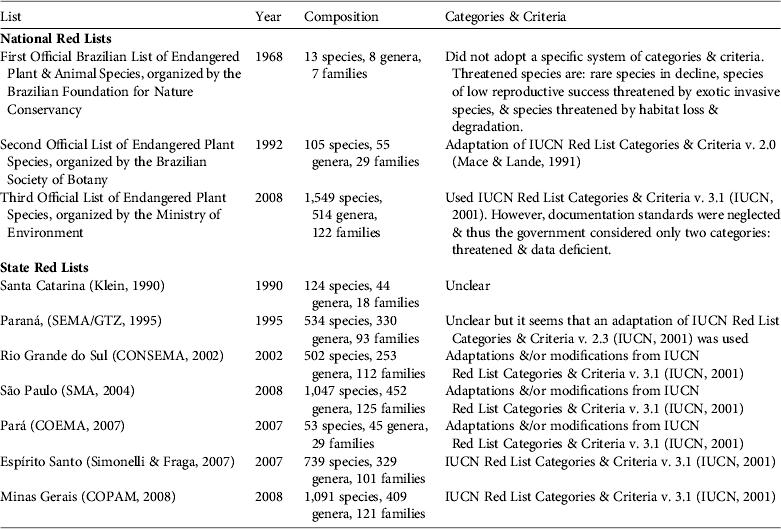
The resulting database of taxa was edited for taxonomic synonyms and repetitions, using the accepted names established by the Catálogo de Plantas e Fungos do Brasil (Catalogue of Brazilian Plant and Fungi Species; Forzza et al., Reference Forzza, Leitman, Costa, Carvalho, Peixoto and Walter2010), a database that contains 94,141 taxa, including accepted names and synonyms (Forzza et al., Reference Forzza, Leitman, Costa, Carvalho, Peixoto and Walter2010). We compared the number of species in each family, in higher taxonomic groups (Table 2), and the number of species assessed at global, national and state levels. We also quantified the number of species transferred among the three levels, to evaluate the effectiveness of state Red Lists in contributing to national and global assessments. As there is no regulation in Brazil for determining national standards for Red Listing of plant species, different systems have been applied and a variety of categories adopted. For our purposes, uniformity with the IUCN v. 3.1 system (IUCN, 2001) was indispensable to allow comparisons with other national Red Listing processes and to establish a national baseline for long-term monitoring. Therefore, categories considered in previous Red Listing efforts were all standardized to the IUCN v. 3.1 system (Table 3).
Table 2 Number of species in the flora of Brazil, by group, with number (and percentage) of species on the national Red List and number (and percentage) of species categorized as Data Deficient.

Table 3 To facilitate analysis categories considered in earlier Red Lists were standardized to the IUCN v. 3.1 (IUCN, 2001) framework.
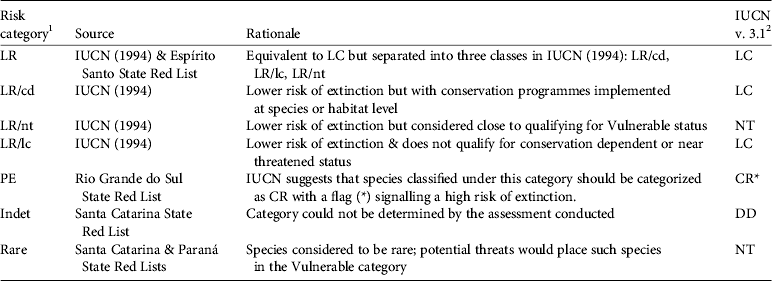
1 LR, Lower Risk; LR/cd, Lower Risk/conservation dependent; LR/nt, Lower Risk/near threatened; LR/lc, Lower Risk/least concern; PE, Probably Extinct; Indet, not determined
2 LC, Least Concern; NT, Near Threatened; CR*, Critically Endangered with a flag of possibly extinct; DD, Data Deficient
We performed an extensive literature review, which included government documents, regulations, national official reports and global frameworks, to establish which common methods were used to assess risk of extinction in the lists analysed. In the discussion we identify the strengths and weaknesses of the Red Listing process in Brazil.
Results
The compiled species list comprised 4,708 taxa (c. 10% of the Brazilian flora), in 1,210 genera and 221 families, considered threatened at global, national and state levels (Fig. 1). The data cleaning process generated discrepancies, as some synonyms were listed as different species. The final compilation of the number of threatened species, genera and families may therefore be slightly different from the official publications (Table 1). The families Orchidaceae, Asteraceae, Bromeliaceae, and Fabaceae contain the most species (Fig. 2). At national level, the number of species assessed by the Brazilian government represents c. 13% of the country's flora (Table 2). During the scientific stage of the 2008 Red Listing process c. 5,000 species were assessed and taxonomists determined that 1,549 species were threatened (Biodiversitas, 2008). The results were formally forwarded to the Brazilian government for the societal stage (political validation). Nevertheless, 1,078 species (69.6% of 1,549) were regarded as Data Deficient (i.e. lacking information or having inappropriate documentation; Table 2) and were withdrawn from the publication (MMA, 2008), which considered only 471 species (30.4% of 1,549) as officially threatened with extinction. However, the criteria used by government representatives to validate the results presented by the taxonomists are unclear or not properly documented.
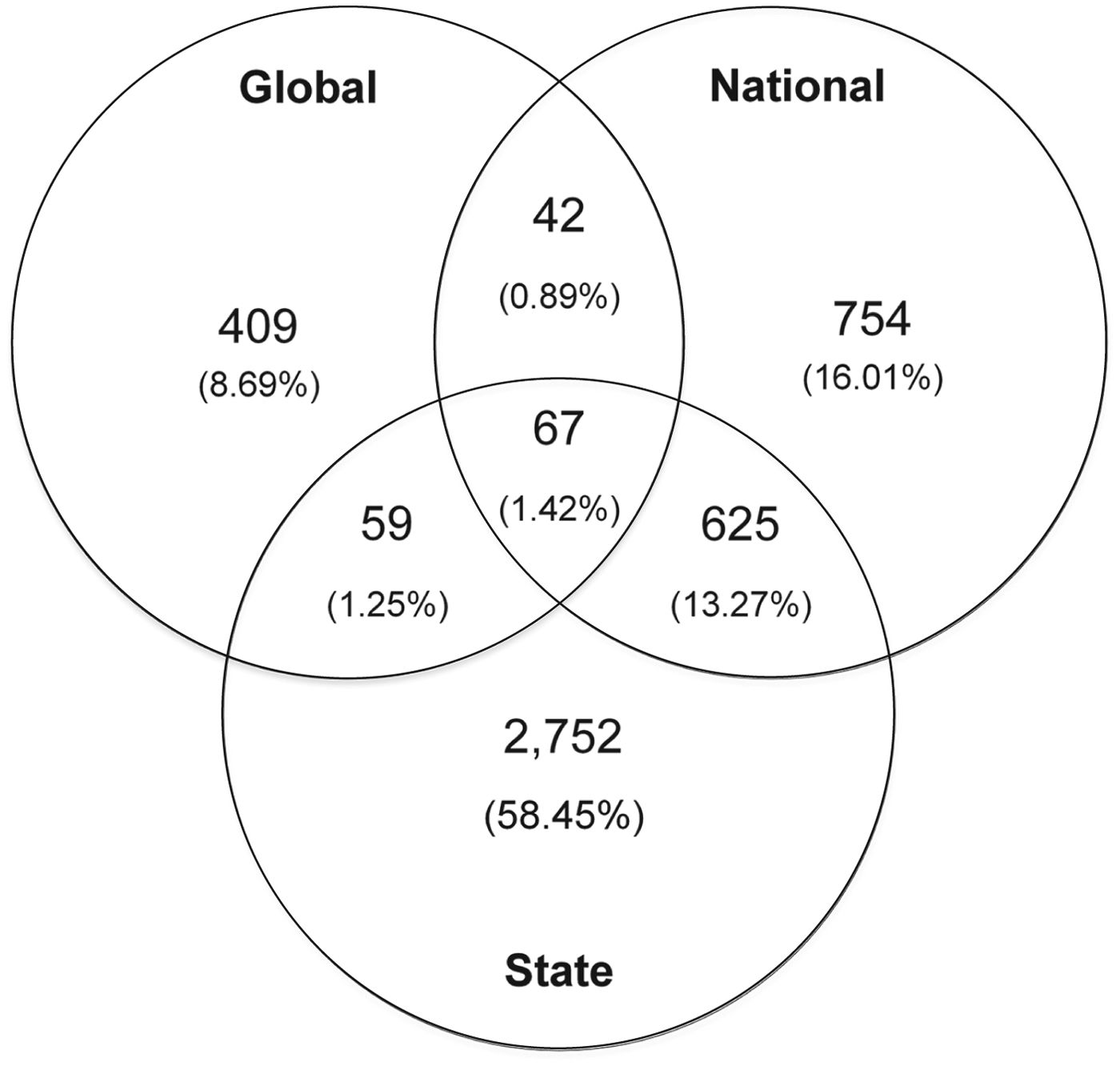
Fig. 1 The number (and percentage) of plant species in Brazil on the compiled list (see text for further details) of 4,708 species considered threatened at global, national and state levels. The overlaps indicate the numbers (and percentages) of species assessed at more than one level.
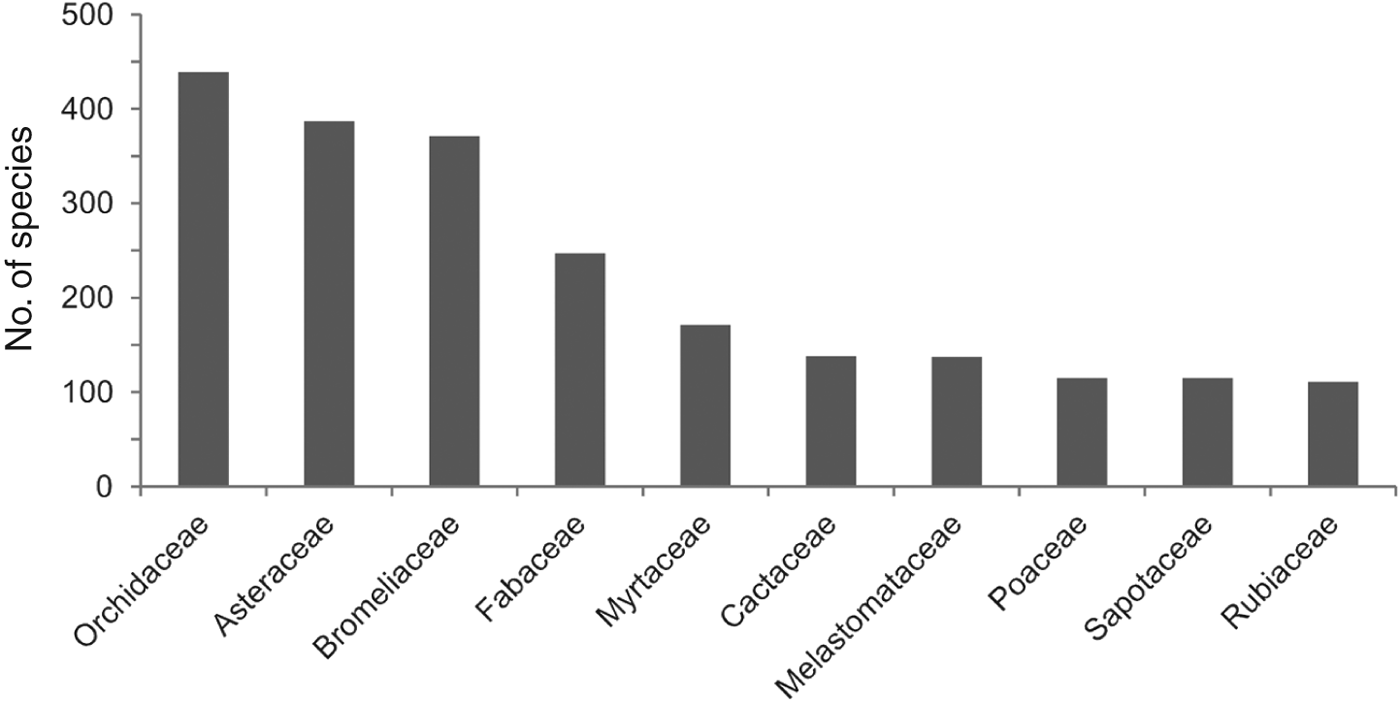
Fig. 2 Number of species in each of the 10 richest plant families in the flora of Brazil.
The lack of information on population structure, ecological characteristics and threats limits the value of the Red List. We found that there was a lack of documentation on exclusions of taxa included in previous versions of the national Red List. Only 62% (Fig. 3) of the taxa in the 1968 Red List were included in the 1992 Red List; 38% were excluded without properly documented justification. In contrast, in 2008 almost the entire 1992 list was incorporated into the current list (MMA, 2008) but there was no documentation justifying the few exclusions.
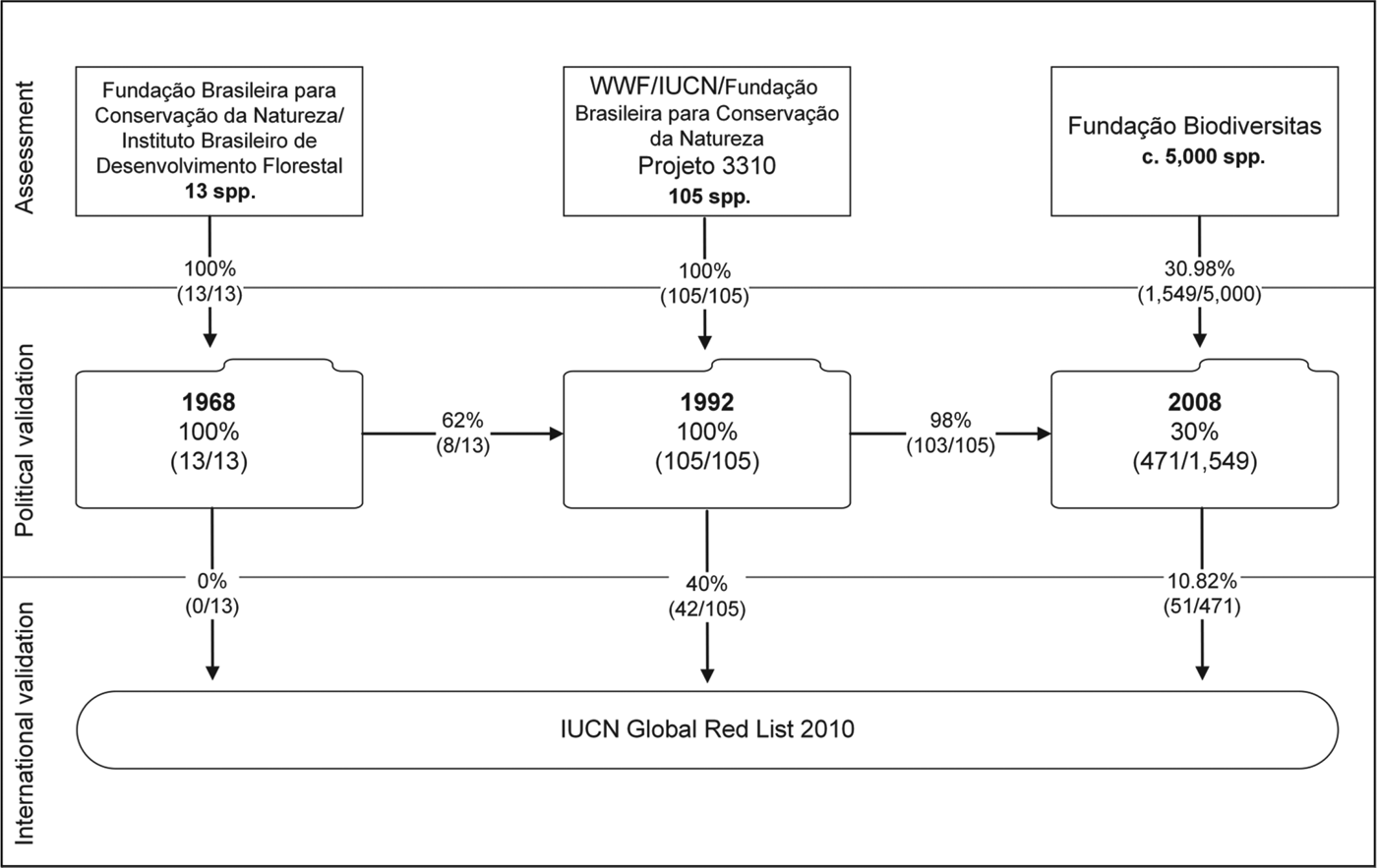
Fig. 3 The number of plant species considered by each process (conservation assessment, political validation and international validation) leading to the 1968, 1992 and 2008 versions of the Brazilian Red List, and the percentage of species that moved from one list to the other.
State Red Listing processes in Brazil provide information on species for processes undertaken at the national level. A total of 4,804 threatened species have been included in state Red Lists, and 14.07% of these have been included in the national list as threatened (202) or data deficient (474). Although this is a low percentage of the total number of plant species in the country, this contribution to the national Red List is relevant as it helps facilitate information flow between local scientific authorities and the government agency responsible for the national Red Listing process. The states of Minas Gerais, São Paulo and Espírito Santo contributed the majority of species included in national assessments. These states are diverse biologically and have had historically high levels of exploitation of natural resources. In addition, there is a concentration of botanists and universities in this south-east region, which results in a large volume of information.
Comparison of species composition at different assessment levels shows that only a few species assessed regionally were actually incorporated into the IUCN Red List, despite high rates of endemism (42.61%; i.e. 18,609 of 43,671 species; Flora do Brasil, 2013). Only 22.71% of the 471 species listed nationally and 2.37% of the 4,804 species assessed at state level were included in the IUCN Red List. Regional adaptations of the IUCN system seem to have generated incomplete assessments that do not comply with information requirements or with documentation standards. These adaptations have resulted in inaccurate interpretations of the extinction risk of species, leading to assignment of different Red List categories for endemic species at state, national and global levels.
Comparisons of the percentages of species in the different categories at the state, national and global scales (Table 4) indicate a subjective bias in the listing process. Of the Brazilian plant species in the IUCN Red List 45% are in low risk categories (Near Threatened or Least Concern) whereas in the national and state Red Lists only c. 5% of species are categorized in low risk categories. Differences between assessments at the global and national levels would be expected if a significant percentage of the distributions of species were in neighbouring countries. However, 68% of the species assessed at global level in low risk categories are endemic. Therefore, these findings indicate different interpretations or inconsistencies in the Red Listing process.
Table 4 Percentage of species assessed globally, nationally and regionally (state level) in Brazil, in each risk category (IUCN, 2001).

Discussion
The last updating of the Brazilian Red List (MMA, 2008) delivered several advances in relation to previous efforts (1968 and 1992): access to a variety of institutional datasets has been improved, an interdisciplinary network of scientists from different geographical regions has been created and mobilized to take part in the Red Listing process, and the scientific stage of the Red Listing process has been separated from the societal stage. Combined, these advances have led to a significant increase in species number on the Red List. The current list has four times more taxa than that of 1992, demonstrating a broadening of conservation databases, better data processing skills at research institutions, and greater numbers of taxonomists working on conservation of flora. However, the number of plant species on the national Red List will probably continue to increase before the conservation of plant species in Brazil improves. Any increase in the number of species on the Red List should not therefore be considered in a negative light. At the national level only 10% (c. 5,000) of the recorded plant species have been assessed and broadening the coverage of the Red List will inevitably lead to the categorization of more species as threatened. The majority of species on the Brazilian Red Lists (Carvalho, Reference Carvalho1968; IBAMA, 1992; MMA, 2008) were included based on suggestions from taxonomists or reports from technical meetings. Decisions were therefore based mainly on inferences made from the information available, whether qualitative or quantitative, and documented or not. As a result, the Brazilian Red List of threatened plant species has always been more useful for supporting the national environmental licensing process than for its original purpose, which is to serve as a national tool to prevent extinction of plant species and define conservation priorities. In Brazil only those species believed to be under threat of extinction were included in risk assessments and quantitative risk indicators were not used to support the assessments.
Adaptations and modifications (Table 1) of various versions of the IUCN system of categories and criteria have resulted in a medley of classification systems in Brazil. The lack of methodological consistency and standards between assessment levels makes it difficult to integrate conservation efforts. Consequently, it is difficult to compare Red Lists made at the state, national, and global levels. In most cases methods are poorly described, and species’ profiles are not properly documented, making it impossible to trace the history of a species’ conservation status.
De Grammont & Cuarón (Reference De Grammont and Cuarón2006) considered the system adopted in Brazil one of the least adequate of 25 systems adopted by 20 American countries. The current situation shows that inconsistencies in Red Listing at national and state levels remain, and the rigorous information requirements of the IUCN preclude the inclusion of several assessments undertaken regionally. In 2008 South Africa concluded a comprehensive assessment of the whole flora of the country (Raimondo et al., Reference Raimondo, Staden, von Foden, Victor, Helme and Turner2009) and, despite a rigorous application of the IUCN categories and criteria, the results have never been included in the global Red List. IUCN's capacity to manage information received is constrained by the limited availability of resources, which represents a barrier to more encompassing perspectives regarding the global conservation status of flora. Furthermore, for the global Red List IUCN does not include assessments that do not comply with information requirements and documentation standards until any outstanding issues have been addressed (Vié et al., Reference Vié, Hilton-Taylor and Stuart2009). As a result a significant number of assessments of endemic species within a country are not included in the global Red List (e.g. Garcia & Galeano, Reference García and Galeano2006; León et al., Reference León, Romero, Arana, Parades, Ramirez and Peña2006; Llamozas et al., Reference Llamozas, de Stefano, Meier, Riina, Stauffer and Aymard2003). The IUCN categorization system has been used in several countries for national assessments (De Grammont & Cuarón, Reference De Grammont and Cuarón2006) and it has been criticized because of its extensive requirements for biological and ecological information (Reca et al., Reference Reca, Ubeda and Grigera1994; Cofré & Marquet, Reference Cofré and Marquet1999; Grigera & Rau, Reference Grigera and Rau2000). Another important weakness (Table 5) identified is the lack of legal instruments to ensure national standardization of the Red Listing process in Brazil. In the absence of overriding national legal guidelines, each federal state established its own regulations. However, most of these regulations are outdated and differ in methods and procedures from those adopted nationally. This lack of alignment creates a schism between state and federal policies that prevents mainstreaming of plant conservation efforts in Brazil. To increase the use of state Red Lists, assessments should be made as part of a regional process and they should follow national Red Listing standards aligned to the standards for applying IUCN Red List criteria at the regional level (Gärdenfors et al., Reference Gärdenfors, Hilton-Taylor, Mace and Rodríguez2001; IUCN, 2003).
Table 5 The strengths and weaknesses of the national Red Listing process in Brazil.
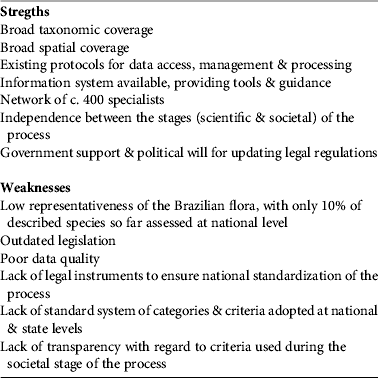
In addition, regulatory processes related to the conservation of threatened plant species in Brazil are not up-to-date with the scientific community's conceptual and methodological advances. It is therefore important to create and maintain better communication between scientists and decision-makers. New findings and advances achieved by the scientific community must be rapidly incorporated into legislation. The need for communication amongst these groups is clearly a challenge (Scarano & Martinelli, Reference Scarano and Martinelli2010) as each considers different aspects of the same subject, and exchange of information has not been fully integrated into the decision-making process. However, if we are able to ally these different interests we may be able to achieve a more effective national conservation strategy, set in motion with a rigorous listing process for plants threatened with extinction.
The inclusion of species in a national Red List should be considered the first step to conservation, and not the end of the process. The categorization of a species as threatened does not on its own increase the probability of survival in nature. For this reason we must focus on standardizing the listing process and base it on a coherent scientific model. Along with this standardization, recovery strategies and action plans for the conservation of threatened species must be developed and become joint initiatives guided by biologists, conservationists and the government in an integrated approach to save our species.
Biographical sketches
All authors work at Centro Nacional de Conservação da Flora (CNCFlora, the Brazilian National Centre for Flora Conservation), which promotes plant conservation in Brazil. Miguel de Moraes coordinates the threatened species programme. His research interests include plant ecology and conservation planning. Rafael Borges is responsible for the taxonomic revision of the working species list and has a special interest in the family Asteraceae. Eline M. Martins coordinates the Action Planning for Flora Conservation project. Ricardo A. Fernandes has developed the organization's database and is responsible for information management. Tainan Messina works to establish links between plant specialists and the assessment team and coordinates the Red List project. She is also responsible for assessment of extinction risk. Gustavo Martinelli coordinates CNCFlora and is the Brazilian focal point for the Global Strategy for Plant Conservation. His particular interests are the reproductive biology of the family Bromeliaceae, and mountain biodiversity.












